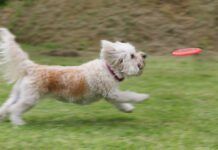Have you ever heard of rage syndrome in dogs? The term “Cocker Rage” has been used to describe the sudden onset of aggression without any apparent cause in the English Cocker Spaniel breed. Rage syndrome in dogs is also known as idiopathic aggression.
So, what is idiopathic aggression in dogs and can it be cured or successfully managed?
What is Idiopathic Aggression?
Idiopathic aggression in dogs is aggression that is explosive in nature, unprovoked, and appears suddenly, often without warning. According to Overall (1997)[i], dogs in the midst of an idiopathic aggression episode may foam at the moth and twitch. Seizures can cause similar symptoms and should be ruled out. Indeed, it can be difficult to identify the overlap between behavioral and neurological diagnoses. Idiopathic aggression appears to be most common in dogs aged 1 to 3 years of age.
Research by Wojewodzic and Sell-Kubiak (2024)[ii] which looked into aggressive behavior in the English Cocker Spaniel breed identified a number of risk factors. These included:
- Males were more likely to show aggression compared to females
- Aggression towards people and other animals increased with age
- English Cocker Spaniels adopted from a shelter were more likely to display aggression towards people
- Dogs that did not have a pedigree or Kennel Club certification were more likely to display aggressive behavior
A separate study by Engdahl et al (2023)[iii] also found that male English Cocker Spaniels were more likely to show aggression compared to females. Interestingly, they also found that aggression was higher in solid-colored dogs.
We still don’t know exactly what causes idiopathic aggression because it’s a very difficult condition for researchers to study as they are unable to induce it.
Symptoms of Idiopathic Aggression?
The main symptom of idiopathic aggression in dogs is intense and unpredictable outbursts of aggression which seemingly occur out of the blue. These episodes of aggression often appear like an overreaction to a relatively benign situation and can be dangerous, especially if there are children or other pets in the home.
Behavioral signs may include freezing, staring, dilated pupils, showing the whites of the eye (whale eye), and baring teeth which can rapidly escalate to biting and lunging. Owners often report that their dog appears “possessed” and even confused during and immediately following episodes of idiopathic aggression.
How is Idiopathic Aggression Diagnosed?
Fortunately, idiopathic aggression is a very uncommon condition. Most dog owners mistakenly believe their dog has idiopathic aggression when in fact, the aggressive episodes they have witnessed are a symptom of underlying illness, pain, fear, or anxiety or are related to resource guarding behavior.
Idiopathic aggression in dogs must be diagnosed by a veterinarian as it is a complex condition and can be difficult to diagnose. Your veterinarian will conduct a thorough physical and neurological examination and may run a blood analysis and other tests to inform their diagnosis. If your regular vet is unsure of how to diagnose rage syndrome in dogs, they may refer you to a specialist who is more experienced with the condition.
A thorough veterinary examination and health and behavioral history are vital to assist in distinguishing between idiopathic aggression and aggression resulting from illness, pain, fear, anxiety, or resource guarding.
How to Manage Idiopathic Aggression in Dogs
Unfortunately, there is no known cure for idiopathic aggression because the underlying causes remain poorly understood. If your dog has been diagnosed by a veterinarian as having idiopathic aggression, management of the condition is paramount to ensure your safety and your dog’s welfare. In many cases Idiopathic aggression can be successfully managed by taking the following steps:
- Avoid using punishment, such as yelling or physical corrections, as punishment can escalate aggression and prolong the problem.
- Identify any triggers for aggression and avoid them when possible to help prevent strengthening the neural pathways in the brain from previous responses.
- Work with a qualified professional to learn how to effectively manage and use behavior modification strategies, such as desensitization and counterconditioning.
- Your vet may prescribe medication for your dog to support management and address any fear or anxiety which may be contributing to the aggressive outbursts.
According to Dobson (2012)[iv], in extreme cases, management may not be possible or feasible to ensure the safety of the adults, children, and other pets in the home. For dogs displaying severe aggression over a long period of time and where the triggers are widespread, unavoidable, and relatively benign (e.g. normal, everyday events), the high degree of safety risks, difficulty and stress of permanently, consistently maintaining the required precautions and the impact on human and canine quality of life, together with a poor prognosis for improvement, lead to serious consideration of euthanasia as the most appropriate course of action.
The good news is that the vast majority of cases of aggression in dogs are behavioral rather than pathological in nature and caused by factors such as pain, illness, fear, anxiety, or resource guarding. Fortunately, these types of aggression can be successfully managed and modified under the guidance of a qualified, positive reinforcement focused trainer, certified applied animal behaviorist, or veterinary behaviorist to achieve significant improvement, maintain good welfare, and reduce the risk of injury to people.
[i] Overall, K. L. (1997). Clinical behavioral medicine for small animals (pp. xvi+-544).
[ii] Wojewodzic, D., & Sell-Kubiak, E. (2024). Effect of dogs characteristics on aggressive behaviour towards humans and other animals in English Cocker Spaniels. Applied Animal Behaviour Science, 275, 106293.
[iii] Engdahl, K. S., Brodbelt, D. C., Cameron, C., Church, D. B., Hedhammar, Å., & O’Neill, D. G. (2023). Demography and disorders of English Cocker Spaniels under primary veterinary care in the UK. Canine Medicine and Genetics, 10(1), 4.
[iv] Dobson, J. (2012). Human-directed canine aggression. Veterinary Times, 42(45), 14.






